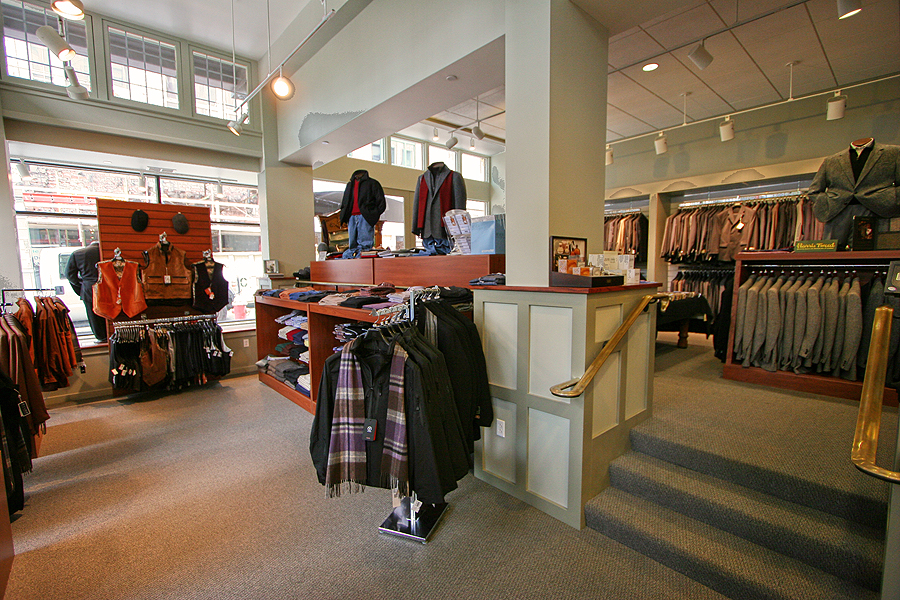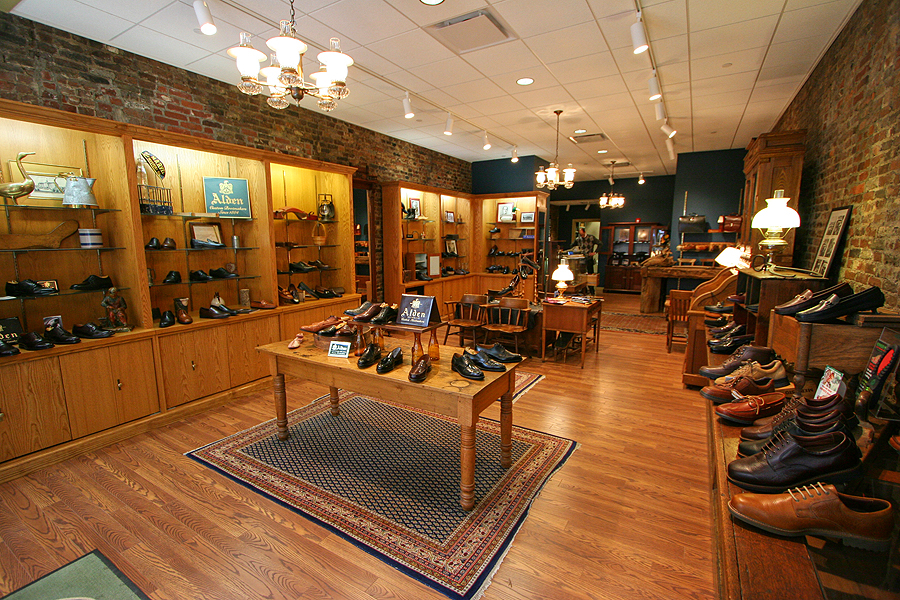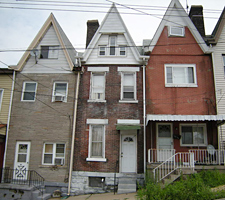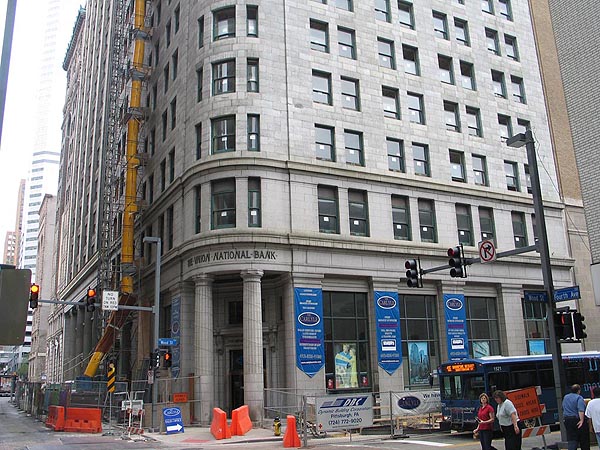
Category Archive: Downtown Development
-
Market at Fifth Shops Open
PHLF News
October 23, 2009Heinz Healey’s men’s store and Nettleton Shoes now occupy the retail space at Market at Fifth.
Their handsome stores opened in time for the G-20 and sales have been brisk.
We are receiving many compliments both on the appearance of the restoration of the buildings and on the quality interiors for these stores. Visit soon.
PHLF members should identify themselves to signify our support.
https://phlf.org/marketatfifth/


-
Neighborhood & Main Street Properties Available
Pittsburgh History & Landmarks Foundation
Main Street Properties for Sale & Lease: Click Here
Market at Fifth: Apartments & Retail Space in Pittsburgh’s Historic Downtown
From time to time, PHLF lists other properties for sale and lease. These listings can be found here when they are available.
——————————————————————————————————————-
Links Provided For Your Convenience, does not imply endorsement.
City of Pittsburgh Properties For Sale
The City of Pittsburgh, in an effort to reduce the number of vacant or abandoned properties, has created sources that offers a menu of properties for sale. Many of these properties are in Pittsburgh’s most historic neighborhoods.

The Real Estate Division of the Department of Finance and the Urban Redevelopment Authority accepts inquiries from the general public for purchase of those properties.
Properties for Sale
Court Auction Sales
Sealed Bid Sales
Side Yard Sales
Vacant Lots for Sale
-
Landmarks receives preservation easement on historic downtown building
April 2, 2009
PHLF NewsOhio-based Spruce Street Properties, Ltd. has donated a preservation easement to Pittsburgh History & Landmarks Foundation on the exterior of The Carlyle, at Fourth Avenue and Wood Street that is being converted to luxury condominiums.
A preservation easement is a voluntary legal agreement made between a property owner and an authorized preservation organization to preserve the exterior of a historic building and assure appropriate alteration. The easement will be recorded with the deed, run in perpetuity and assist current and future owners in preserving the buildings historic and architectural features.
Pittsburgh History & Landmarks Foundation will be the monitoring agent for the easement and received a donation from Spruce Street Properties to assure the necessary funds to defend and monitor the easement forever.
“David Bishoff, a long-time owner of many buildings in Pittsburgh and a staunch supporter of maintaining the wonderful fabric of downtown through the preservation of its historic buildings, is to be commended for protecting the exterior of this important building which is a contributing structure in the Fourth Avenue Historic District,” said Foundation President Arthur Ziegler. “Once again, a creative developer has shown how we can move forward by building on our past.”
The Carlyle, formerly the Union National Bank Building, was designed by MacClure & Spahr and constructed in 1906. The 21-story neo-Classical building was a focal point of Pittsburgh?s Fourth Avenue financial district, once one of the most significant financial centers in the country. The Carlyle will provide downtown residential ownership starting at $279,000.
Pittsburgh Mayor Luke Ravenstahl attended the Foundation’s board meeting when the announcement was made.
-
Public Hearing on 200-210 Fifth Ave, and 438 & 440 Market Street
PREPARED TESTIMONY OF
ANNE E. NELSON, ESQ.
GENERAL COUNSEL
PITTSBURGH HISTORY & LANDMARKS FOUNDATION
BEFORE HISTORIC REVIEW COMMISSION, CITY OF PITTSBURGH
PUBLIC HEARING ON 200-210 FIFTH AVENUE; 438 & 440 MARKET STREET
NOVEMER 5, 2008
As the future holder of a preservation easement on the Buhl Building and current holder of design control rights on the adjacent properties, Landmarks supports N&P Properties’ plans to rehabilitate the exterior of the Buhl Building, demolish the adjacent structures, and build a new building adjacent to the Buhl. The size, scale, and color of the proposed adjacent building compliment the blue terra cotta Buhl Building. Landmarks’ support of N & P Properties’ plans for the Buhl Building and adjacent structures, however, is contingent on the Pennsylvania Historical and Museum Commission approving Part 2 of their Federal Rehabilitation Tax Credit application.
-
Public Hearing at Historic Review Commission on 200-210 Fifth Avenue, and 438 & 440 Market Street
PREPARED TESTIMONY OFANNE E. NELSON, ESQ.
GENERAL COUNSEL
PITTSBURGH HISTORY & LANDMARKS FOUNDATION
BEFORE HISTORIC REVIEW COMMISSION, CITY OF PITTSBURGH
PUBLIC HEARING ON 200-210 FIFTH AVENUE; 438 & 440 MARKET STREET
NOVEMER 5, 2008
As the future holder of a preservation easement on the Buhl Building and current holder of design control rights on the adjacent properties, Landmarks supports N&P Properties’ plans to rehabilitate the exterior of the Buhl Building, demolish the adjacent structures, and build a new building adjacent to the Buhl. The size, scale, and color of the proposed adjacent building compliment the blue terra cotta Buhl Building. Landmarks’ support of N & P Properties’ plans for the Buhl Building and adjacent structures, however, is contingent on the Pennsylvania Historical and Museum Commission approving Part 2 of their Federal Rehabilitation Tax Credit application.
-
‘Lazarus’ on the Hill?
By Glen Meakem
Pittsburgh Tribune Review
Sunday, August 31, 2008In 1998, Pittsburgh celebrated as the “glitzy” new Lazarus department store opened on Fifth Avenue, Downtown. In the spring of 2004, after just five years, Pittsburghers mourned as the store closed its doors forever — another blow to a city struggling to succeed.
Now Pittsburgh politicians and community leaders face another economic decision — which grocery store to build in the Hill District. I am hoping, for the sake of Hill residents and city taxpayers of all neighborhoods, that our leaders will choose the best long-term economic answer instead of short-term glitz.
The Lazarus project was a costly mistake. In order to attract the store, the Urban Redevelopment Authority lent Lazarus $18 million and the city provided $5 million in additional cash. Despite the large government subsidies, once construction was completed and the doors opened, sales were well below expectations.
Lazarus was obligated to begin repaying the $18 million loan once in-store sales reached $41 million per year. But peak sales never exceeded $22 million. The taxpayer loan never was repaid. Even with more than $20 million of government subsidies, Lazarus sustained big losses and was forced to close.
The truth is Lazarus might have worked if marketproblems — high parking taxes and the lack of downtown residential living — had been addressed first. Instead, politicians chose a reality-ignoring strategy that cost taxpayers tens of millions of dollars and dealt Pittsburgh a tough blow.
The first proposal for the Hill District grocery store is being presented by St. Louis-based grocer Save-A-Lot. Its store is economically viable, based on a business model that works and experience with more than 1,200 stores around the country.
Save-A-Lot deliberately keeps its stores smaller than other grocers, eliminating amenities such as on-site bakeries, pharmacies and dry cleaners. It also limits inventory to approximately 1,200 frequently purchased items — what the corporation refers to as an “edited assortment.”
By keeping its stores small, forgoing amenities that increase the costs of doing business, and stocking only the most popular items in the most commonly purchased sizes, Save-A-Lot claims it saves customers 40 percent on food purchases.
The company is experienced in providing quality service to urban markets like the Hill District. According to Mayor John Thompson of Wilkinsburg, where a Save-A-Lot opened in 2007, the store has surpassed the community’s expectations, providing not only quality food at low prices but also many jobs to community residents and financial support to local charity efforts.
Save-A-Lot says it would not be economically viable to build a full-service grocery store on the Hill. But the small size of the proposed building project (16,500 square feet) would allow additional businesses to move into the Center Avenue location over time (such as a pharmacy), complementing the smaller grocer.
The new Save-A-Lot building is projected to cost $5 million to $6 million and can be up and running in less than a year.
The second proposal, presented by Kuhn’s, is not based on experience or a proven business model.
Similar to the “glitz” of Lazarus, this proposal calls for a $24 million revitalization project that includes a 50,000-square-foot Kuhn’s Market, among other stores. The plan surprised many, since Kuhn’s previously stated — along with Giant Eagle and Aldi — that it was not interested in building a grocery store on the Hill.
Unlike Save-A-Lot, Kuhn’s is a local, family-owned business with eight locations but no experience in urban markets. Yet some community leaders and activists see this more ambitious plan — including a pharmacy, bakery, deli, meat counter and fresh fish section — as a better fit for the neighborhood.
The proposed Kuhn’s project would require an as-yet-unspecified level of taxpayer support above the $2 million in subsidies already promised by the URA and the Pittsburgh Penguins.
Before making their decision, Pittsburgh leaders also should consider one more set of facts: Grocery shopping habits are changing all over the country.
According to a 2007 Gallup Poll, 46 percent of adults say higher food costs are creating financial hardships.
Prices climbed 5 percent in 2007 and 6 percent in 2008 (the largest single-year jump since 1990).
Americans are now buying fewer luxury food items and more store brands.
According to Willard Bishop, a Barrington, Ill., consulting firm, limited-assortment grocery stores such as Save-A-Lot enjoyed an increase in sales of more than 16 percent last year while sales at full-service grocery stores rose only 3 percent.
The Save-A-Lot proposal is in line with current trends while the Kuhn’s proposal runs against them.
The last few days of summer are upon us and community leaders are struggling to make the right decision between two very different grocery store proposals. Will this generation of leaders choose the proven business concept from the company with experience that is likely to serve the Hill community for many years to come?
Or, as their predecessors did with Lazarus, will they choose the expensive, unproven model from a company relying on big government subsidies with no experience in the market it is entering?
In the business world, we call this decision a “no-brainer.” Political and community leaders should choose the commonsense solution over government-subsidized “glitz” and go with Save-A-Lot.
Hill District residents and city taxpayers from all neighborhoods will thank them for it.
Glen Meakem, founder and original CEO of FreeMarkets Inc., a business-to-business Internet company Downtown, is co-founder and managing director of Meakem Becker Venture Capital.
-
Downtown’s Union Trust building gets major tenant
Tuesday, August 05, 2008 -
Union Trust gets first major tenant
By Sam Spatter
FOR THE TRIBUNE-REVIEW
Tuesday, August 5, 2008Downtown’s Union Trust Building on Monday obtained its first major lease since it was purchased by new ownership — with Siemens Engineering signing a 10-year lease to occupy three to six floors in the landmark building.
Siemens Engineering, a unit of Siemens AG, is consolidating its local environmental engineering operations in the building, said Jeremy Kronman, executive vice president of CB Richard Ellis, who headed a team that represented the owner, MIKA Realty Group of Los Angeles.
“We will relocate about 500 Siemens people from 441 Smithfield St. and Oxford Centre, both Downtown, along with personnel in the Crane Building in the Strip District, starting in October and complete it during November, and add several hundred more jobs as we grow,” said Siemens Engineering President Tony DoVale.
In February, Siemens received $2.95 million in state aid in return for a pledge to create 550 jobs within three years. It said at that time that a $5 million expansion project could triple its local operations.
Kronman said the office space leased by Siemens could accommodate up to 1,200 workers.
The 600,000-square-foot building, undergoing a major renovation, was purchased by MIKA Realty Group in February for $24.1 million and was 99 percent vacant. It formerly had been occupied by Mellon Bank as an operations center.
“This tenant is a natural fit with the nature of this development: Siemens’ focus on environmental engineering directly matches our vision of a LEED-rated corporate facility of the highest quality,” said Michael Kamen, principal of MIKA Realty Group, and his investment partner, Jerry Fox, in a statement.
As part of the upgrading of the 11-story building, MIKA has placed a $250,000 scuptured tree in the lobby as “an indication of the rebirth of the building.”
Other improvements that are part of the remodeling include a new lobby, new restrooms, installation of a lower-level parking facility, upgrades to conference facilities and 325-seat theater/auditorium, new exterior lighting, new storefronts and exterior cleaning.
Kronman indicated that other leases may be forthcoming for the building but declined to identify the companies.
Formerly known as Wheelabrator Air Pollution Control Inc., Siemens is a custom manufacturer of air pollution control equipment and systems for industrial and utility applications.
Representing Siemens were Gerry Dudley, Kurt Mrazik, Paul Novello and Jeff Babikian of CBRE’s Corporate Services Group.
Sam Spatter can be reached at sspatter@tribweb.comor 412-320-7843.


